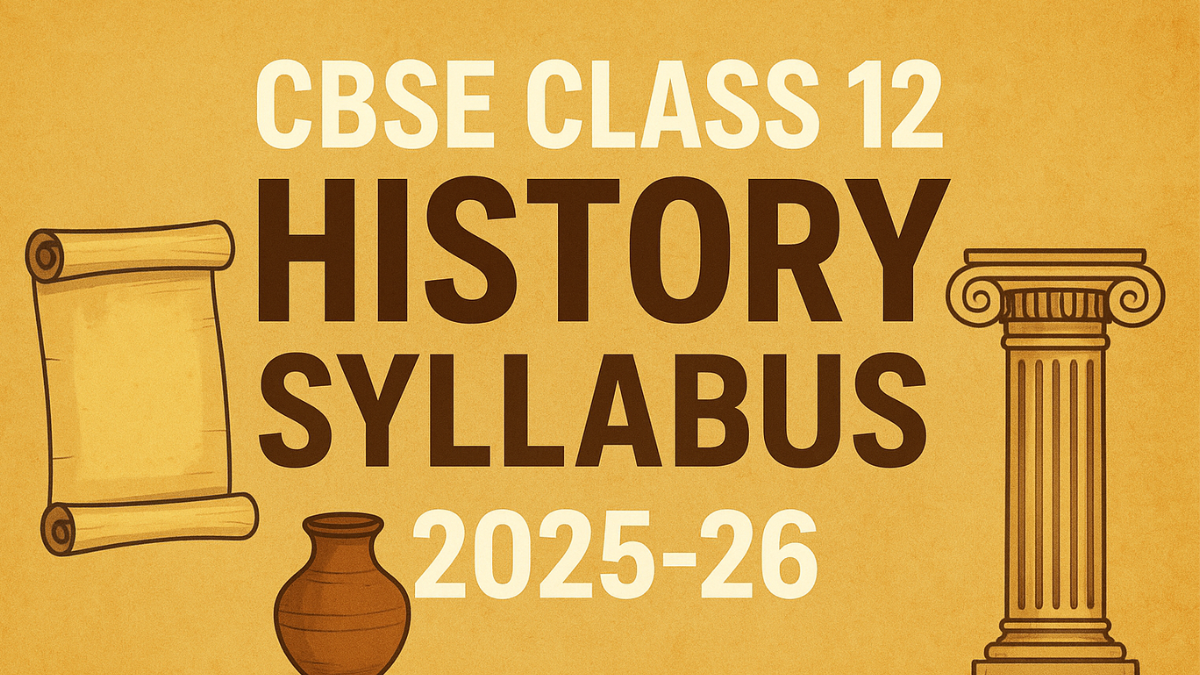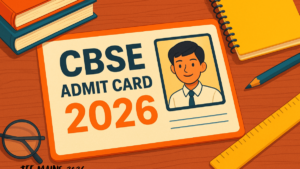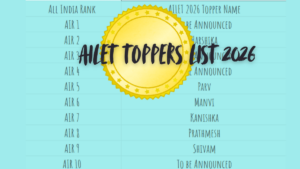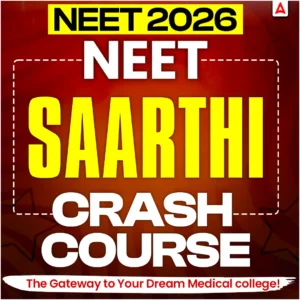The CBSE Class 12 History Syllabus 2025-26 is organised into three sections to provide a thorough understanding of India’s rich history: ancient, medieval, and modern. It discusses important topics such as the Harappan Civilisation, early states and societies, the Mughal Empire, colonial rule, the liberation struggle, and the development of the Indian Constitution. You have an arts background and are preparing for the CBSE Class 12 History exam in 2025-26. Understanding the curriculum is critical to effective study and achievement. Download the Official History Class 12 Syllabus CBSE 2025-26 PDF and start your preparation with strategic planning.
CBSE Class 12 History Syllabus 2025-26
The Central Board of Secondary Education (CBSE) has officially issued the Class 12 History syllabus for the academic year 2025–26. The syllabus is designed to help students develop critical thinking, historical interpretation, and source-based learning skills. The CBSE Class 12 Syllabus 2025-26 for History incorporates theory-based instruction, map work, and project work to ensure a comprehensive grasp of historical events. With 80 marks assigned to theory and 20 marks for projects, take a look at the CBSE Class 12 History Syllabus 2025-26: Course Structure
| Part | Theme | Marks |
| Part I | Themes in Indian History – I | 25 |
| Part II | Themes in Indian History – II | 25 |
| Part III | Themes in Indian History – III | 25 |
| Map Work | Based on all three parts | 5 |
|
Total Theory Marks
|
80 | |
| Project Work | 20 | |
| Grand Total | 100 | |
How many chapters are in History Class 12 CBSE?
CBSE Class 12 History is divided into 12 chapters, thoughtfully organized into three parts to make learning easier and engaging. The first part, Themes in Indian History – 1, covers ancient Indian history, exploring early societies and cultures. Themes in Indian History – 2 focuses on the medieval period, highlighting kingdoms, administration, and cultural developments. Finally, Themes in Indian History – 3 takes you through modern India, freedom struggles, and contemporary changes, giving students a complete journey through India’s past. Take a look at the chapter-wise marks distribution below:
| Themes in Indian History Part I | ||
| Sr No. | Theme Title | |
| 1 | Bricks, Beads and Bones The Harappa Civilisation | 25 marks |
| 2 | Kings, Farmers and Towns Early States and Economies (c.600 BCE 600 CE) |
|
| 3 | Kingship, Caste and class Early Societies (c. 600 BCE600 CE) |
|
| 4 | Thinkers, Beliefs and Buildings Cultural Developments (c. 600 BCE 600 CE) |
|
| Themes in Indian History Part-II | ||
| 5 | Through the eyes of Travellers Perceptions of Society (c. tenth to seventeenth centuries) |
25 marks |
| 6 | Bhakti-Sufi Traditions Changes in Religious Beliefs and Devotional Texts (c. eighth to eighteenth centuries) |
|
| 7 | An Imperial Capital – Vijayanagar (c. fourteenth to sixteenth centuries) | |
| 8 | Peasants, zamindars and the States Agrarian Society and the Mughal Empire (c. sixteenth-seventeenth centuries) | |
| Themes in Indian History Part-III | ||
| 9 | Colonialism and The Countryside Exploring Official Archives |
25
|
| 10 | Rebels and Raj 1857 Revolt and its Representations |
|
| 11 | Mahatma Gandhi and the National Movement Civil Disobedience and Beyond | |
| 12 | Framing of the Constitution The Beginning of a New Era |
|
| Including Map work of the related Themes | 5 | |
| Theory Total | 80 | |
| Project Work | 20 | |
| TOTAL | 100 | |
History Class 12 Syllabus CBSE 2025-26
The CBSE Class 12 History syllabus for the academic year 2025–26 is divided into three parts under “Themes in Indian History.” It covers important topics such as the Harappan Civilization, Early States and Economies, and Colonialism and the Countryside. This structured approach helps students understand India’s historical developments, from ancient urban societies to economic systems and the impact of colonial rule on rural life, providing a clear and comprehensive learning framework.
Part 1: Themes in Indian History
|
Chapter No. and Title
|
Topics Covered |
| Chapter 1: Bricks, Beads and Bones The Harappa Civilisation |
❖ Investigate, explore and interpret the early urban centres and social institutions.
❖ State and deduce the multi-lateral aspects of Harappan civilisation to understand the first civilization of the world. ❖ Investigate and interpret historical and contemporary sources and viewpoints of ASI and historians on Harappa. |
| Chapter 2: Kings, Farmers and Towns Early States and Economies (c.600 BCE600 CE) |
❖ Critically evaluate and interpret major trends in the political and economic history of the subcontinent.
❖ Decode inscriptional evidence. ❖ Analyse inscriptional evidences and the ways in which these have shaped the understanding of political and economic processes. |
| Chapter 3: Kingship, Caste and Class Early Societies (c. 600 BCE600 CE) |
❖ Examine, analyse the issues of social history.
❖ Analyse social norms in order to understand the perspectives of society given in the scriptures of ancient India. ❖ Examine the varied dimensions explored by historians in order to understand dynamic approach of Mahabharata. |
| Chapter 4: Thinkers, Beliefs and Buildings Cultural Developments (c. 600 BCE600 CE) |
❖ Infer and compare the major religious developments in early India.
❖ Elucidate the rich religious sculpture and infer the stories hidden in it. ❖ Create a picture album of the Buddhist Sculpture. |
Part 2: Themes in Indian History
| Chapter No. and Title | Topics Covered |
| Chapter 5: Through the Eyes of Travellers Perceptions of Society (c. tenth to seventeenth centuries) |
❖ Understand salient features of social histories described by the travellers and apply the learning in real life.
❖ Elucidating the accounts of foreign travellers in order to understand the social political and economic life during the tenure of different rulers in the medieval period. |
| Chapter 6: Bhakti-Sufi Traditions: Changes in Religious Beliefs and Devotional Texts
(c. eighth to eighteenth centuries) |
❖ Understand the religious developments.
❖ Summarise the philosophies of different Bhakti and Sufi saints to understand the religious developments during medieval period. ❖ Comprehend the religious movement in order to establish unity, peace harmony and brotherhood in society. |
| Chapter 6: Bhakti-Sufi Traditions Changes in Religious Beliefs and Devotional Texts
(c. eighth to eighteenth centuries) |
❖ Students will be able to Classify the distinctive architectural contributions of the Vijayanagar empire to comprehend the richness of mingled cultures of deccan India.
❖ Analyse accounts of foreign traveller’s on Vijayanagar in order to interpret political, social and cultural life of the city. ❖ Assess and appreciate the city planning, water management system, administration of the rulers. |
| Chapter 8: Peasants, Zamindars and the States Agrarian Society and the Mughal Empire
(sixteenth-seventeenth centuries) |
❖ Comprehend the facets of agrarian developments in order to understand the relationship between the state and the agriculture during Mughal period. ❖ Compare and contrast the agrarian changes occurred during sixteenth and seventeenth centuries. ❖ Make a table and bring out the differences in the agrarian sector. |
Part 3: Themes in Indian History
| Chapter No. and Title | Topics Covered |
| Chapter 9: Colonialism and The Countryside Exploring Official Archives |
❖ Evaluate the revenue systems introduced by the British to understand the economic aspects of colonization in India.
❖ Analyse the colonial official records& reports to understand the divergent interest of British and Indians. ❖ Find solution to be taken to protect the peasants and artisans in this century. |
| Chapter 10: Rebels and Raj 1857 Revolt and its Representations |
❖ Examine the events of 1857.
❖ Correlate the Planning and coordination of the rebels of 1857 to infer its domains and nature. ❖ Examine the momentum of the revolt to understand its spread. ❖ Analyse how revolt created vision of unity amongst Indians. ❖ Interpret visual images to understand the emotions portrayed by the nationalist and British. |
| Chapter 11: Mahatma Gandhi and the National Movement Civil Disobedience and Beyond |
❖ Understand the nationalist movement in chronological order.
❖ Correlate the significant elements of the nationalist movement and the nature of ideas, individuals, and institutions under the Gandhian leadership. ❖ Debate on the significant contributions of Gandhi to understand his mass appeal for nationalism. ❖ Explore the ways of interpreting historical sources such as newspapers, biographies and autobiographies diaries, and letters |
| Chapter 12: Framing of the Constitution The Beginning of a New Era |
❖ Highlight the role of Constituent Assembly to understand functionaries in framing the constitution of India.
❖ Analyse how debates and discussions around important issues in the Constituent Assembly shaped our Constitution |
CBSE Class 12 History Syllabus 2025-26 PDF Download
The PDF for the CBSE Class 12 History Syllabus 2025-26 has been officially published by the board, eliminating the confusion regarding the curriculum. For a smooth preparation, you need to first download and take printouts of the same. You may download the History Class 12 Syllabus CBSE 2025-26 simply by clicking the link shared below.
CBSE Class 12 History Syllabus- Map List
The CBSE Class 12 History course structure includes 20% internal evaluation through examinations and assignments. Maps are an important aspect of evaluation, so understanding which topics will be included in the 2025 board exams will be beneficial. Check the list of maps below:
| No | Page No. | Part – I Maps |
| 1 | 2 |
Mature Harappan sites: Harappa, Banawali, Kalibangan, Balakot, Rakhigarhi, Dholavira, Nageshwar, Lothal, Mohenjodaro, Chanhudaro, KotDiji.
|
| 2 | 3 |
Mahajanapada and cities: Vajji, Magadha, Kosala, Kuru, Panchala, Gandhara, Avanti, Rajgir, Ujjain, Taxila,
Varanasi. |
| 3 | 33 |
Distribution of Ashokan inscriptions:
· Pillar inscriptions – Sanchi, Topra, Meerut Pillar and Kaushambi. · Kingdom of Cholas, Cheras and Pandyas. |
| 4 | 43 |
Important kingdoms and towns:
· Kushanas, Shakas, Satavahanas, Vakatakas,Guptas · Cities/towns: Mathura, Kanauj, Puhar, Braghukachchha, Shravasti, Rajgir, Vaishali, Varanasi,Vidisha |
| 5 | 95 |
Major Buddhist Sites: Nagarjunakonda, Sanchi, Amaravati, Lumbini, Bharhut, Bodh Gaya, Ajanta
|
| S. No | Page No. | Part II – Maps |
| 6 | 174 |
Bidar, Golconda, Bijapur, Vijayanagar, Chandragiri, Kanchipuram, Mysore, Thanjavur, Kolar, Tirunelveli
|
| 7 | 214 |
Territories under Babur, Akbar and Aurangzeb:
· Delhi, Agra, Panipat, Amber, Ajmer, Lahore, Goa. |
| S. No | Page No. | Part III – Maps |
| 8 | 287 |
Territories/cities under British Control in1857: Punjab, Sindh, Bombay, Madras Berar, Bengal, Bihar,
Orissa, Surat, Calcutta, Patna, Allahabad |
| 9 | 260 |
Main centres of the Revolt of 1857: Delhi, Meerut, Jhansi, Lucknow, Kanpur, Azamgarh, Calcutta, Benaras, Gwalior, Jabalpur, Agra, Awadh
|
| 10 |
Important centres of the National Movement: Champaran, Kheda, Ahmedabad, Benaras, Amritsar, Chauri Chaura, Lahore, Bardoli, Dandi, Bombay (Quit India Resolution), Karachi
|










 IMO Results 2025-26, Check SOF Math Olym...
IMO Results 2025-26, Check SOF Math Olym...
 CBSE Admit Card 2026 for Private & R...
CBSE Admit Card 2026 for Private & R...
 AILET 2026 AIR 1: Check Full Toppers Lis...
AILET 2026 AIR 1: Check Full Toppers Lis...













